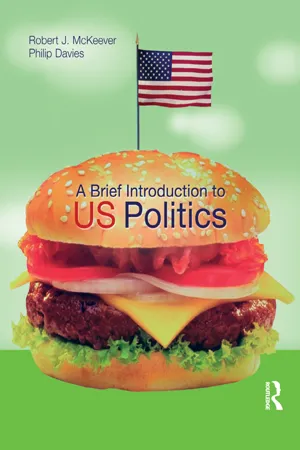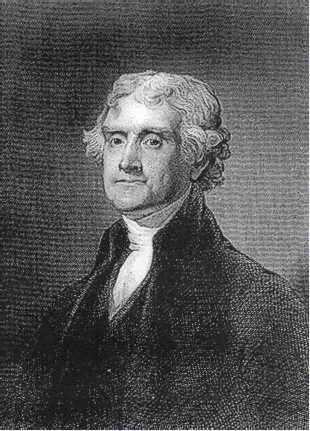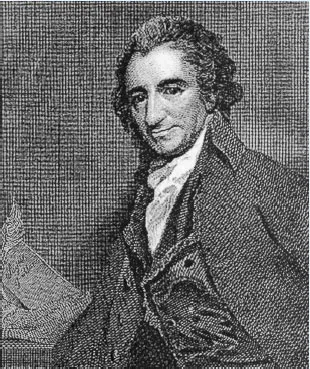![]()
Chapter 1
The Constitution and constitutionalism
This chapter examines the origins, development and impact of the single most important document in American politics – the Constitution of the United States. The Constitution provides not only a framework for government in America, but also a way of thinking about government. For inseparable from the Constitution is the idea of constitutionalism – the belief that all things governmental and political must comply with the principles set out in that document. The US Constitution was drafted in 1787 and came into force in 1789. Yet it is no mere historical relic. Because it has been regarded as a ‘living document’, subject to new interpretations as well as formal amendment, it has developed in line with the socioeconomic and political transformation of America from a rural, eastern seaboard nation to a post-industrial, continental power that dominates the world in so many respects. As you might expect, just as America has not achieved this transformation without struggle and contention, so too the Constitution has been fought over and its development has been far from smooth. Nevertheless, it remains the keystone of American government and any understanding of American politics must begin with an appreciation of the Constitution and constitutionalism.
The origins of the Constitution of 1787
The Constitution of 1787 has philosophical roots in the progressive European thought of the eighteenth century, but its driving force was a distinctly practical consideration: how to replace British colonial rule with a government that was effective but not repressive. The United States had been wrestling with this problem since the Declaration of Independence in 1776, but even after the successful conclusion of the War of Independence in 1783, it still had not found a solution. Part of the difficulty lay in the fact that achieving independence and implementing self-government were distinctly different projects, and Americans took some time to make the transition from the one to the other. It was also the case that the people who provided the momentum for independence were not the same as those who seized the initiative to write a new constitution in 1787: not only did they have different goals, but, to some extent, different interests and ideologies too. The outcome was that the more radical thought behind the Declaration of Independence was, in part, replaced by the more pragmatic conservatism of the Founding Fathers. As a consequence, the Constitution emerged as an innovative document that combined radicalism, conservatism and sheer pragmatism. That combination is still evident today and each element needs to be understood by any student of contemporary American politics and government.
The Declaration of Independence and the American Revolution
Historians disagree over the causes of the American Revolution. Some argue that economic rivalry between American and British merchants fanned the flames of revolution, while others point to American resentment of new taxes being imposed on them without consultation. A third view is that Americans were simply developing a national self-consciousness that led naturally to the desire to rule themselves. All of these probably played their part. Certainly the period from the end of the Seven Years War between Britain and France (1756–63) until the Declaration of Independence in 1776 saw rising tensions over clashes of economic interests. The British tried to tax Americans more heavily and to control trade more strictly in the interests of British merchants, both with the aim of recuperating some of the expenses of the war with France. It is also logical that such clashes would increase awareness that British and American interests were not identical and that greater self-rule was desirable in order to nurture America’s distinctive needs.
Where there is broad agreement among historians is that most Americans were reluctant revolutionaries. Indeed, many of those who felt obliged to back the movement for independence saw themselves as fighting to restore the rights of Englishmen, rather than to abandon the political traditions of the Mother Country. In effect, the independence activists were immersed in a political debate between Whigs and Tories in Britain that dated back to the English Civil War. The Whigs took their cue from the writings of the English philosopher, John Locke. Accordingly, they opposed the notion of the divine right of kings to rule as they see fit and believed that each man has natural rights, granted to him by God, that no king or parliament could take away. They also accepted Locke’s belief that governments depend ultimately on the consent of the people: if a government violates the social contract between the ruler and the ruled, then the people have the right to change their government.
Only when they finally realised that they could never persuade George III to accept their Whig agenda, did the Americans turn to independence. As Michael Heale put it, ‘The only course left was rebellion, a rebellion which was begun … not so much against the British constitution as on behalf of it’ (Heale, 1977, p. 34). In this sense, it can be misleading to think of the independence movement as revolutionary. Certainly there was no intention to overthrow the economic or social order that prevailed in the colonies. On the other hand, the mere act of overthrowing an established monarchy through a popular uprising was a radical step. Indeed, the main purpose of the Declaration of Independence was less to announce independence than to justify it. Moreover, the act of fighting for independence did bring forth more radical thinking.
One manifestation of this was the contrast between the new state constitutions that followed in the wake of the Declaration of Independence and the colonial systems of government that preceded them. While the War of Independence was emphatically not fought to create a democracy in America, it did inspire a strengthening of democratic elements in the new constitutions. For example, while no state formally abolished property qualifications for the franchise, states such as New Hampshire, Pennsylvania and Georgia eased them to the point where there was near-universal white male suffrage. Another democratic spurt came in the form of frequent elections to state legislatures, something which increased popular control of political elites.
The Declaration of Independence (1776) and equality
Jefferson’s Declaration consists for the most part of a long list of somewhat contentious accusations levelled at King George III. However, it is best remembered and celebrated for its ringing proclamation of the equality of all men, their possession of unalienable rights, and popular consent and sovereignty as the legitimate basis of government:
‘We hold these truths to be self-evident, that all men are created equal, that they are endowed by their Creator with certain unalienable rights, that among these are Life, Liberty and the pursuit of Happiness.
That to secure these rights, Governments are instituted among Men, deriving their just powers from the consent of the governed, That whenever any Form of Government becomes destructive of these ends, it is the Right of the People to alter or abolish it, and to institute a new Government …’
Thomas Jefferson.
Much debate surrounds Jefferson’s claim that ‘all men are created equal’, given the existence of slavery in the American colonies. Indeed, Jefferson himself was a slave-owner. How can this contradiction be explained, if not by sheer hypocrisy or unconscious racism? In terms of political theory, Jefferson was simply restating John Locke’s premise that, in the state of nature prior to the formation of society, all men are created equal by God. At the same time, Jefferson and some others were clearly aware that slavery was wrong and could do untold harm to America at some point in the future. Of course, they were proved right as a bitter conflict soon developed over the abolition of slavery which culminated in the Civil War (1861–65). The Declaration’s statement of equality was at odds with slavery and, for that reason, it became a rallying cry for abolitionists. Other groups, most obviously women, have also invoked the Declaration of Independence in their struggles for liberty and equality. It has thus proved an invaluable tool for those determined to make American practice match the promise of the American Revolution.
At the national level, however, the most obvious radical development was the decision to replace a monarchy with a republic. Whig theory allowed for both monarchical and republican systems of government, but even in the years immediately prior to independence, most Americans thought of republicanism in pejorative terms. It was a close relative of the even more alarming concept of democracy, which was equated with ‘mob rule’. Yet practical considerations pushed Americans into republicanism, including the impossibility of finding an American royal family to replace the British one. Embracing a republic, however, required a deliberate and careful attempt to distinguish it from democracy. As a result, American constitutionalism after independence was based on incorporating democratic elements of government, while ensuring that they were contained by elitist counterbalances.
While most of those who led the independence movement retained aristocratic or even monarchist leanings, there were more radical voices, such as that of Thomas Paine, the English pamphleteer, and Sam Adams, the Massachusetts politician. These radicals pushed hard in the direction of popular control of government. Between 1776 and 1789 they were engaged in something of a political struggle with the conservatives to control America’s political destiny. The historian Donald Lutz argues that the radicals had the upper hand at first, but had lost their grip by 1787. As a result, ‘the political theory underlying the Declaration of Independence of 1776 is not the same as that underlying the Constitution of 1787. The theory of consent implicit in the Declaration not only does not naturally evolve into the Constitution but in some important respects is contradictory to it’ (Lutz, in Graham and Graham, 1977, p. 61).
Thomas Paine’s Common Sense The Rule of Law Should Replace the Rule of Kings
In his famous work Common Sense, published on the eve of the War of Independence in 1776, Paine sought to reassure those who feared the vacuum that would be left by the overthrow of the monarchy. The rule of the king, he said, would be replaced by the rule of law.
‘But where says some is the King of America? I’ll tell you Friend, he reigns above, and doth not make havoc of mankind like the Royal of Britain. Yet that we may not appear to be defective even in earthly honors, let a day be solemnly set apart for proclaiming the charter; let it be brought forth placed on the divine law, the word of God; let a crown be placed thereon, by which the world may know, that so far as we approve of monarchy, that in America THE LAW IS KING. For as in absolute governments the King is law, so in free countries the law ought to be King; and there ought to be no other.’
Thomas Paine.
Paine was considered a dangerous radical by the British and, indeed, by many Americans. With hindsight, however, Paine was simply in the vanguard of the movement for American democracy and his ideas came to be embraced by most Americans.
Whatever the nuances of political theory and the clash of interests and factions, there remains a common core to American politics in the period 1776–87. The most important was a commitment to republicanism and a government based on popular consent. This embraced political ideas and rhetoric that facilitated, over time, the emergence of a modern democracy. In short, while the War of Independence was not fought to create a democracy and while the Constitution did not produce one, both contained seeds of democracy that were to germinate and flourish in time.
The Articles of Confederation 1781–1789
The Articles were America’s first constitution and they embodied the spirit of 1776. The Americans had fought to overthrow a distant, centralised government. It was logical, then, to replace it with government close to the people and that meant government at the state level. As a result, the Articles provided only for the very weakest of national governments. There was no national executive or judiciary at all. And the national legislature – the Congress – was so constituted that it was, as Merrill Jensen put it, ‘the creature of the state governments and thus...



